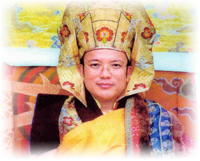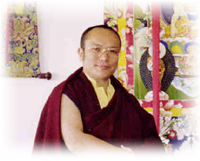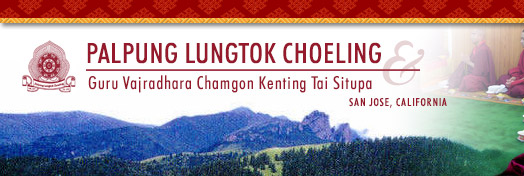

|
Guru Vajradhara Chamgon Kenting Tai Situpa
Guru Vajradhara Chamgon Kenting Tai Situpa is the twelfth in an unbroken line of incarnations, which began in the 11th century. A spiritual master of unsurpassed significance in the history of Tibetan Buddhism, he was trained by the 16th Gyalwa Karmapa and is the current holder of the main Kagyu lineage. The title Kenting Tai Situ means "far reaching, unshakable, great master, holder of the command."
The origin of the Tai Situpas can be traced to one of the senior followers of Shakyamuni Buddha, the bodhisattva Maitreya, who has been prophesied as the next Buddha, the fifth of the 1,000 Buddhas to appear in this fortunate aeon.
An early and important incarnation in Tibet was that of Marpa Lotsawa, the great teacher of Milarepa. Marpa helped revive Buddhism in Tibet undergoing many hardships on journeys to India to acquire Buddha's teachings, which he later translated, and form the core instructions of the Kagyu School of Buddhism.
The great Indian mahasiddha, Padmasambhava clearly foretold all the names of the Situpa incarnations in a treasure text known as The Command Seal of Prophecies (Tib, Lungten Kagyama), which was later discovered by the great terton Sangye Lingpa. The Situpa incarnations have been very closely connected to the Karmapas; alternating as teacher and disciple from one lifetime to the next. The first to carry the title Situpa was Chokyi Gyaltsen (1377-1448). However the specific lineage began with Drogon Raychen (1088-1158) who was a close disciple of the 1st Karmapa.
Guru Vajradhara Chamgon Kenting Tai Situpa was born in 1954 in Palyul District of the Derge Kingdom, East Tibet, into an agricultural family. He was identified according to traditional methods and at the age of eighteen months, he was enthroned at Palpung Monastery, the main seat of the Tai Situpas in eastern Tibet. When he was six years, old political circumstances forced him to leave Tibet with a few attendants, journeying first to Bhutan and then to Sikkim where he was united with the 16th Karmapa. During this time of adversity, his struggle to survive as a refugee was exacerbated by illness. During his convalescence he went to live at the newly built monastery at Rumtek in Sikkim, the new seat of the 16th Karmapa. At the age of twenty-one he assumed his own traditional responsibilities and established a monastery called SherabLing at the request of some of his Tibetan followers who have settled in northern India.
In 1980 he made his first European tour at the request of Buddhist organizations and since then has traveled widely in North America, Europe, South-East Asia, and New Zealand, lecturing on Buddhist philosophy and meditation. He visited Tibet in 1984 for the first time since leaving, and again in 1991, journeying to his historical seat, Palpung Monastery. During this visit he ordained more than 2000 men and women and presented a plan of suggestions to the Chinese authorities for the rebuilding, preservation, and propagation, of the Tibetan Buddhist culture.
A renowned artist and calligrapher, Guru Vajradhara Chamgon Kenting Tai Situpa speaks fluent English and is the author of several books in which he illuminates Buddhist teachings in commonsense terms using down-to-earth examples. He is currently involved in the advancement of inter-faith and inter-cultural humanitarian efforts and was the inspiration and motivator for the 1989 Pilgrimage for Active Peace. In addition, Rinpoche is the founder and Spiritual Head of the extensively enlarged SherabLing Monastery. Rinpoche was also involved with the recognition of His Holiness 17th Gyalwa Karmapa Ogyen Trinley Dorje, and is able to offer him the complete transmission of the Mahamudra lineage.
| |



